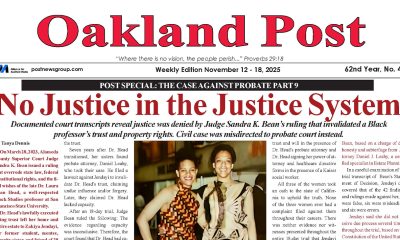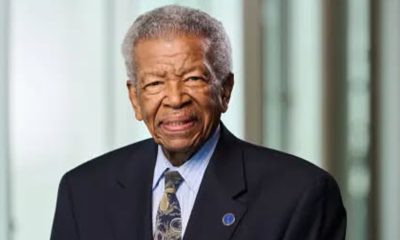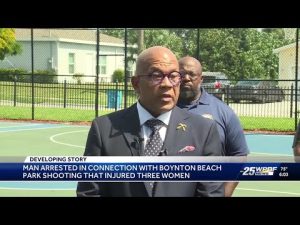#NNPA BlackPress
Lenora Closes Out Women’s History Month Headlining “Jazzy Sundays” at Emancipation Park
Photos by Darryl Howard Photography The Kinder Foundation’s free concert series “Jazzy Sundays in the Parks” celebrates the legacy of jazz in Houston. This month’s series at Emancipation Park concluded Sunday night, with singer-songwriter Lenora headlining. Backed by her four-piece band, Lenora performed a set of self-penned originals and unique covers in an intimate, indoor […]
The post Lenora Closes Out Women’s History Month Headlining “Jazzy Sundays” at Emancipation Park first appeared on BlackPressUSA.


Photos by Darryl Howard Photography
The Kinder Foundation’s free concert series “Jazzy Sundays in the Parks” celebrates the legacy of jazz in Houston. This month’s series at Emancipation Park concluded Sunday night, with singer-songwriter Lenora headlining. Backed by her four-piece band, Lenora performed a set of self-penned originals and unique covers in an intimate, indoor experience rich with community and connectivity.

Lenora performs in the Jazzy Sundays concert series at Emancipation Park
The first three “Jazzy Sundays” took place outside. But due to the forecast, Sunday’s concert got moved indoors. Rainy days can put a damper on a show, and Lenora, herself, was distraught when she learned about the venue change: “I literally cried,” she says while laughing. “But everything worked out better than I could have ever imagined. The sound and the intimacy of it was incredible. And it ended up being something different than any of the other ones. I feel like we got to connect on a one-to-one basis with everyone that was in that space.”
In the final night of Kinder’s Emancipation Park series, Lenora connected with a crowd that packed the room to capacity. And as this month’s only female headliner, she got to close out Women’s History Month in style.

Lenora encourages crowd participation
The jazz theme initially posed a challenge for Lenora, who decided to just be herself. “At first I was kind of overthinking it,” she admits. “People ask me, ‘What genre of music would you fit under best?’ I describe the genre that my music subscribes to as ‘R&G’ or ‘Rhythm & Groove.’ But truthfully, my music is pretty genre-bending or even genre-defying.”
“I really just decided to not overthink it and just bring me to the show,” she says. “Jazz is improvisation; jazz is a feeling.”
That same philosophy helped her create her dynamic setlist, which was initially difficult. “I was getting really caught up on the jazz thing and wondering if I needed to sing more standards. Whenever I would think about the setlist, I would get in my head but when I actually sat down to put the show together, I just sat at my kitchen table with a cup of coffee in silence. I closed my eyes with a blank sheet of paper in front of me, and I asked myself: ‘How do you want the show to feel? What feeling do you want to impart upon the audience? What experience do you want them to have?’ And it just flowed after that.”
The final setlist contained mostly original compositions; as an independent artist, Lenora feels it’s important to perform her own songs. “I want to hear more original music from independent artists. I know Houston’s live music scene is bananas in the best way. Like we have some of the greatest talent here and I know that a lot of places, we hear cover music, which is dope. But I always want to hear more original music from localized talent. I am an advocate for that.”

Jazzy Sundays audience members look on in admiration during Lenora’s performance
“My favorite music to perform is my own,” she adds, saying that “there’s just nothing like performing your own compositions and all the music that I performed last night that was original was all written by me, if not co-written with me.”
The concert presented ten Lenora originals, along with three covers. One of them was the opener: Lenora began the performance with a stunning version of the Dramatics’ 1971 hit “Whatcha See Is Whatcha Get.”
“I love that song. That is one of my favorite songs. I always wanted to perform that song in a live setting, but I would never do it because I didn’t want to do it without horns. There’s a lot of brass in that song.” But she chose the song as her opener because of its familiarity — and its theme of authenticity.

Lenora pictured with her band (L-R: David Hutson, Jesse Gomez, Lenora, Halston Luna and MBK)
“I wanted to start with something familiar to everyone, and I also am aware that everyone from teenagers to seniors come to my show… I wanted it to be something everyone felt good about ‘cause that’s a feel-good song. And I also felt like the words to it are very much me,” she says. “I always say that what you see is what you get with me. I’m always the same, the same me.”
Lenora gave the audience another glimpse of who she is with her next song, “Cool.” She wrote that song to challenge misconceptions about her: “I always felt like people had the wrong idea of me. Sometimes people think I’m this diva with this huge ego, and I’m like, I’m just cool,” she laughs. Y’all be thinkin’ I’m siditty when I wrap my head in a satin bonnet just like everybody else, she sings on the track.
Subsequently, Lenora featured songs from Girls — her experimental debut album that documented her journey through womanhood at the time. She wanted to take fans from “outside” to inside. “Outside being a time in my life where I was exploring, partying and dating, and then going inside to realizing that most of that stuff is just stuff that you’re using to try to distract you from facing yourself.” Songs in the “outside” vein include “After Party” by Koffee Brown and her own song “Tonite” — a bass-heavy, trippy song about a girls’ night out. On her breezy ditty “Part-Time Lover,” she took the entire audience to the bridge with some three-part harmony.

Lenora gives an emotional performance of “Good To Me”
There were also some sweet moments during the show – like when Lenora sang “Crush on You,” which she wrote about her now-fiancé. “I love doing ‘Crush on You’ when Jarren’s in the audience,” she says. “I’ve done it like that before, but this time was really special just because he was sitting in a space where all my family and loved ones were.”
Lenora brought the blues to Jazzy Sundays with her song “Good to Me.” Her grandmother was a major blues fan, so it felt natural for Lenora to include it. A raw freestyle about being undervalued in relationships, the song was angrier and more confrontational than anything else on the setlist. Lenora performed the song with a gritty, raw delivery, so gut-wrenching that she dropped to her knees on stage. She says the song forced her to go to a dark, emotional place.
“‘Good to Me’ was about a collection of unfortunate relationships. So it’s like two or three relationships comprised into one song. So when I’m performing that song, there’s certain parts where I can recall confronting someone I was in a relationship or ‘situationship’ with,” she says. “When I sing that song, I go back to those exact moments of conflict. I’m in such a better space now, being loved properly and healing – such a better space. So, to go back there…it’s just tough. But it’s necessary.”

Caroline Harris (center) celebrates her birthday at Jazzy Sundays and is serenaded by Lenora
Also tough but necessary: grief. Lenora dedicated her cover of the Jackson 5’s “Never Can Say Goodbye” to her late grandmother. “I dedicated it to my grandmother, who I called my mama: Lenora ‘Doll’ Carter. I’m named after her; Lenora was her name. She raised me since I was two days old. And she was the publisher & CEO of the Forward Times before. She passed away in 2010 but her birthday was March 12th. And so I’ve been having a tough time – even though there’s been so much time that’s passed since then – just understanding that life goes on and that time is passing. And also, just missing her so much.
I had never done anything in a live performance that was in her honor, ever. So I just wanted to do it, especially being in Third Ward and Emancipation Park, which is right around the corner from our office [Forward Times]. Being in the office every day is bittersweet, because it makes me happy to help contribute to the legacy that she and my grandfather established. But it also makes me incredibly sad because everything reminds me of her here.”
Lenora brought members of the audience to tears with her tribute to her late Mama. She honored her mother’s advice (and lightened the mood) with “Red Flags,” a bouncy number about warning signs in a relationship. “That may have been my favorite one to perform on Sunday night,” she says, “because I had a lot of fun with that.” She got the audience clapping and singing along, joining her in a chant: “If you see a red flag, point it out in the sky/If you see a red flag, there is no compromise.”
She closed with a trilogy of songs: “Homebody,” “Relax,” and “Power.” “I just feel like all of those songs flow into each other and they all have a common theme of prioritizing self-care,” she says. “I feel like all of them carry that thread, so I love performing them sort of as a little trio because I think they all are saying something similar. I love when we get to that part at the end of the show and we’re able to impart that feeling on everybody. I love when people leave feeling different in a good way.”
During “Relax,” she had audience members close their eyes, breathe in, and breathe out, joining her in a calming meditation. “It’s important for us to catch our breaths,” she says. “I love doing that meditation piece and allowing everybody to just be present.”
Ending with her latest single, “Power” was important to Lenora. “I think it’s one of the most important songs that I’ve released,” she says, “because realizing and recognizing your own power and then doing something about it literally changes your whole trajectory in life. It’s important to end with that message.”
Lenora has another message for her listeners after the concert. What at first seemed like a disappointment (moving indoors) turned into an intimate experience that allowed her to connect with her audience. That yielded an important lesson: “Don’t defeat yourself because things don’t go according to plan. It’s quite possible that things could turn out far better than you could ever imagine.”
The post Lenora Closes Out Women’s History Month Headlining “Jazzy Sundays” at Emancipation Park appeared first on Houston Forward Times.
The post Lenora Closes Out Women’s History Month Headlining “Jazzy Sundays” at Emancipation Park first appeared on BlackPressUSA.
#NNPA BlackPress
LIHEAP Funds Released After Weeks of Delay as States and the District Rush to Protect Households from the Cold
BLACKPRESSUSA NEWSWIRE — The federal government has released $3.6 billion in home heating assistance after a delay that left states preparing for the start of winter without the program’s annual funding.

By Stacy M. Brown
Black Press USA Senior National Correspondent
The federal government has released $3.6 billion in home heating assistance after a delay that left states preparing for the start of winter without the program’s annual funding. The Low-Income Home Energy Assistance Program, known as LIHEAP, helps eligible households pay heating and cooling bills. The release follows a shutdown that stretched 43 days and pushed agencies across the country to warn families of possible disruptions.
State officials in Minnesota, Kansas, New York, and Pennsylvania had already issued alerts that the delay could slow the processing of applications or force families to wait until December for help. In Pennsylvania, more than 300,000 households depend on the program each year. Minnesota officials noted that older adults, young children, and people with disabilities face the highest risk as temperatures fall.
The delay also raised concerns among advocates who track household debt tied to rising utility costs. National Energy Assistance Directors Association Executive Director Mark Wolfe said the funds were “essential and long overdue” and added that high arrearages and increased energy prices have strained families seeking help.
Some states faced additional pressure when other services were affected by the shutdown. According to data reviewed by national energy advocates, roughly 68 percent of LIHEAP households also receive nutrition assistance, and the freeze in multiple programs increased the financial burden on low-income residents. Wolfe said families were placed in “an even more precarious situation than usual” as the shutdown stretched into November.
In Maryland, lawmakers urged the Trump administration to release funds after the state recorded its first cold-related death of the season. The Maryland Department of Health reported that a man in his 30s was found outdoors in Frederick County when temperatures dropped. Last winter, the state documented 75 cold-related deaths, the highest number in five years. Rep Kweisi Mfume joined more than 100 House members calling for immediate federal action and said LIHEAP “is not a luxury” for the 100,000 Maryland households that rely on it. He added that seniors and veterans would be placed at risk if the program remained stalled.
Maryland Gov. Wes Moore used $10.1 million in state funds to keep benefits moving, but noted that states cannot routinely replace federal dollars. His administration said families that rely on medical equipment requiring electricity are particularly vulnerable.
The District of Columbia has already mapped out its FY26 LIHEAP structure in documents filed with the federal government. The District’s plan shows that heating assistance, cooling assistance, weatherization, and year-round crisis assistance operate from October 1 through September 30. The District allocates 50 percent of its LIHEAP funds to heating assistance, 10 percent to cooling, 13 percent to year-round crisis assistance, 15 percent to weatherization, and 10 percent to administrative costs. Two percent is used for services that help residents reduce energy needs, including education on reading utility bills and identifying energy waste.
The District’s plan lists a minimum LIHEAP benefit of $200 and a maximum of $1,800 for both heating and cooling assistance. Crisis benefits are provided separately and may reach up to $500 when needed to resolve an emergency. The plan states that a household is considered in crisis if it has been disconnected from energy service, if heating oil is at 5 percent or less of capacity, or if the household has at least $200 owed after the regular benefit is applied.
The District’s filing notes that LIHEAP staff conduct outreach through community meetings, senior housing sites, Advisory Neighborhood Commissions, social media, posters, and mass mailings. The plan confirms that LIHEAP applicants can apply in person, by mail, by email, or through a mobile-friendly online application and that physically disabled residents may request in-home visits.
As agencies nationwide begin distributing the newly released funds, states continue working through large volumes of applications. Wolfe said LIHEAP administrators “have been notified that the award letters have gone out and the states can begin to draw down the funds.”
#NNPA BlackPress
Seven Steps to Help Your Child Build Meaningful Connections
BLACKPRESSUSA NEWSWIRE — Swinging side by side with a friend on the playground. Sharing chalk over bright, colorful sidewalk drawings. Hiding behind a tree during a spirited game of hide-and-seek. These simple moments between children may seem small, but they matter more than we think

By Niyoka McCoy, Ed.D., Chief Learning Officer, Stride/K12
Swinging side by side with a friend on the playground. Sharing chalk over bright, colorful sidewalk drawings. Hiding behind a tree during a spirited game of hide-and-seek. These simple moments between children may seem small, but they matter more than we think: They lay the foundation for some of life’s most important skills.
Through everyday play, young children begin learning essential social and emotional skills like sharing, resolving conflicts, showing empathy, and managing their emotions. These social skills help shape emotional growth and set kids up for long-term success. Socialization in early childhood isn’t just a “nice-to-have”—it’s essential for development.
Yet today, many young children who haven’t yet started school aren’t getting enough consistent, meaningful interaction with peers. Research shows that there’s a decline in active free play and peer socialization when compared to previous generations.
There are many reasons for this. Children who are home with a parent during the day may spend most of their time with adults, limiting opportunities for peer play. Those in daycare or preschool may have restricted free play, and large classrooms can reduce supervision and social coaching. Some children live in rural areas, are homebound due to illness, have full schedules, or rely on screens to fill their playtime. And for some families, finding other families with young children to connect with isn’t easy.
While these challenges can feel significant, opportunities for connection still exist in every community. Families can take simple steps to help children build friendships, create a sense of belonging, and strengthen social skills. Here are some ideas to get started:
- Storytime sessions at libraries or local bookstores
- Community offerings such as parent-child workshops, art, music, gymnastics, swimming, or sports programs
- Weekly events at children’s museums, which may include art projects, music workshops, or science experiments
- Outdoor exploration, where kids can play with peers
- Local parenting groups that organize playdates and group activities
- Volunteer opportunities where children can participate, such as pet adoption events or packing meals at a food bank
- Classes for kids at local businesses, including hardware, grocery, or craft stores
Some of these community activities are free or low-cost and give kids the chance to build friendships and practice social skills. Parents can also model positive social behavior by interacting with other parents and encouraging their children to play with their peers.
These may seem like small moments of connection, but they can have a powerful impact. Every time your child shares a toy, plays make-believe with peers, or races a friend down the slide, they’re not just playing—they’re learning the skills that build confidence, empathy, and lasting friendships. And it’s good for you, too. Creating intentional opportunities for play also helps you strengthen your own network of parents who can support one another as your children grow together.
#NNPA BlackPress
Seven Steps to Help Your Child Build Meaningful Connections
BLACKPRESSUSA NEWSWIRE — Swinging side by side with a friend on the playground. Sharing chalk over bright, colorful sidewalk drawings. Hiding behind a tree during a spirited game of hide-and-seek. These simple moments between children may seem small, but they matter more than we think

By Niyoka McCoy, Ed.D., Chief Learning Officer, Stride/K12
Swinging side by side with a friend on the playground. Sharing chalk over bright, colorful sidewalk drawings. Hiding behind a tree during a spirited game of hide-and-seek. These simple moments between children may seem small, but they matter more than we think: They lay the foundation for some of life’s most important skills.
Through everyday play, young children begin learning essential social and emotional skills like sharing, resolving conflicts, showing empathy, and managing their emotions. These social skills help shape emotional growth and set kids up for long-term success. Socialization in early childhood isn’t just a “nice-to-have”—it’s essential for development.
Yet today, many young children who haven’t yet started school aren’t getting enough consistent, meaningful interaction with peers. Research shows that there’s a decline in active free play and peer socialization when compared to previous generations.
There are many reasons for this. Children who are home with a parent during the day may spend most of their time with adults, limiting opportunities for peer play. Those in daycare or preschool may have restricted free play, and large classrooms can reduce supervision and social coaching. Some children live in rural areas, are homebound due to illness, have full schedules, or rely on screens to fill their playtime. And for some families, finding other families with young children to connect with isn’t easy.
While these challenges can feel significant, opportunities for connection still exist in every community. Families can take simple steps to help children build friendships, create a sense of belonging, and strengthen social skills. Here are some ideas to get started:
- Storytime sessions at libraries or local bookstores
- Community offerings such as parent-child workshops, art, music, gymnastics, swimming, or sports programs
- Weekly events at children’s museums, which may include art projects, music workshops, or science experiments
- Outdoor exploration, where kids can play with peers
- Local parenting groups that organize playdates and group activities
- Volunteer opportunities where children can participate, such as pet adoption events or packing meals at a food bank
- Classes for kids at local businesses, including hardware, grocery, or craft stores
Some of these community activities are free or low-cost and give kids the chance to build friendships and practice social skills. Parents can also model positive social behavior by interacting with other parents and encouraging their children to play with their peers.
These may seem like small moments of connection, but they can have a powerful impact. Every time your child shares a toy, plays make-believe with peers, or races a friend down the slide, they’re not just playing—they’re learning the skills that build confidence, empathy, and lasting friendships. And it’s good for you, too. Creating intentional opportunities for play also helps you strengthen your own network of parents who can support one another as your children grow together.
-

 Activism3 weeks ago
Activism3 weeks agoOakland Post: Week of November 12 – 18, 2025
-

 Activism3 weeks ago
Activism3 weeks agoIN MEMORIAM: William ‘Bill’ Patterson, 94
-

 Activism3 weeks ago
Activism3 weeks agoHow Charles R. Drew University Navigated More Than $20 Million in Fed Cuts – Still Prioritizing Students and Community Health
-

 Bay Area3 weeks ago
Bay Area3 weeks agoNo Justice in the Justice System
-

 #NNPA BlackPress3 weeks ago
#NNPA BlackPress3 weeks agoThe Perfumed Hand of Hypocrisy: Trump Hosted Former Terror Suspect While America Condemns a Muslim Mayor
-

 #NNPA BlackPress2 weeks ago
#NNPA BlackPress2 weeks agoLewis Hamilton set to start LAST in Saturday Night’s Las Vegas Grand Prix
-

 #NNPA BlackPress2 weeks ago
#NNPA BlackPress2 weeks agoTrump’s Death Threat Rhetoric Sends Nation into Crisis
-

 #NNPA BlackPress4 weeks ago
#NNPA BlackPress4 weeks agoProtecting Pedophiles: The GOP’s Warped Crusade Against Its Own Lies




















































